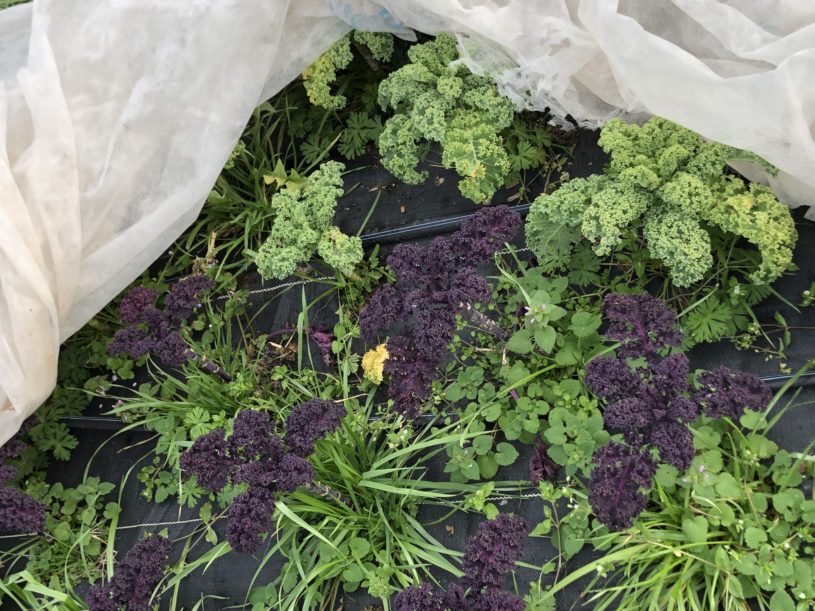
Feb 16, 2023
Defying the cold: How 2 N.C. farmers defend their crops against frost
Phyllis Walsh grows produce year-round as the owner of DabHar Farm in south-central North Carolina. Selling at the Waxhaw farmers market near Charlotte, she finds that even in cold, windy weather, her regular customers come by because they are “really ready for some fresh stuff.”
Walsh uses a variety of frost protection strategies to grow assorted winter vegetables. The first step is choosing which crops to grow under which conditions. Some crops can survive or even thrive in the open field. She plants garlic, for instance, in October or November for a June harvest. She also starts bulb onions in the fall, to get green onions that she can harvest at any time.
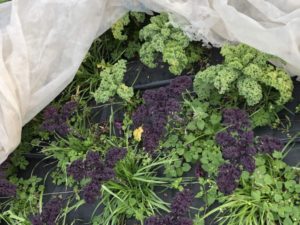
The onions and garlic stood up to a late December polar air blast that plunged the temperature down to 10 degrees, unusually cold for the region.
Brussels sprouts and kale have held their own in the open field, but the cabbages “don’t look so great, and would have done better under cover,” Walsh said, who said she is always learning the limit of each crop.
Walsh’s strawberry plants do fine in the cold, so long as they are not flowering. If they are blooming when a frost is predicted, she covers them with row fabric, rolled onto pipes or posts at the edges to secure it. Along with local varieties, she grows some northern varieties of strawberries that her mother sent her from Iowa, replanting them into a different bed each year.
For less cold-hardy crops, Walsh deploys one or two layers of the second-thinnest type of white polyester row fabric. She finds the fabric sufficient for temperatures down to the upper 20s (normal lows for the area) for carrots, kale, daikon radishes, salad radishes and cauliflower.
She also grows broccolini, chicory and escarole under fabric in the fall until the plants peter out.
When she saw the prediction of the polar blast in late December, she pulled up the salad radishes but left in the daikons. The latter had leaf damage and some of the radishes themselves were mushy at the top if they were poking out of the soil. Everything fully in the soil stayed intact.
For crops requiring more protection, Walsh uses unheated tunnels: a permanent high tunnel and a smaller, portable caterpillar tunnel. The tunnels offer protection not only from frost but also from rain and wind. Wind stresses the plants and dehydrates them, she notes.
The plants are mostly brassicas and lettuce. For example, she seeded radishes, Hakurei turnips, and baby leaf lettuce in the caterpillar tunnel on Jan. 18.
Conventional wisdom says that nothing grows in the Persephone period (when daylight falls below 10 hours per day), from Dec. 1 until Jan. 11 at the DabHar Farm latitude, but to the contrary, Walsh finds “things do keep growing. They may not get as much daylight, but they get warmth” inside the tunnels.
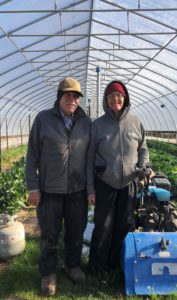
Finally, Walsh has another high tunnel that in most years she heats with propane. “It is always a toss-up. Is it worth me buying propane, or am I trying to grow a $100 tomato?”
She usually plants tomatoes in the tunnel in July and heats the plants in winter, but this year she did not find time to plant them. Instead, she grew celery, peas, spinach and chard in the tunnel without the heater.
“Looking back, I would have gotten the heater going,” she said, because the polar spell knocked out even the cold-hardy peas, just as they were starting to set fruit.
Moving to Plan B, she bought some propane and her daughter planted peas on Jan. 16 for a spring crop. The peas grow on a netting trellis down the middle of the tunnel, with celery planted at the edges. Walsh also plans to put in tomatoes early, to precede the summer market glut.
Unfortunately, crop plants are not the only creatures that thrive in the warmth of the high tunnel. Field rats find the tunnel edges appealing, especially if plants and debris provide good cover. They like to nibble the pea and cucumber plants.
Walsh discourages the rats by removing debris, keeping the ground open so her cat and dog can deter the rats, and pre-sprouting the peas to give the pea plants a head start.
Walsh is careful to not irrigate too much inside the tunnels, as too much water encourages fungal growth. Beyond that, she finds that the scarcity of insect pests makes winter production easier. For this reason, planting peas in the heated tunnel in autumn works better than planting them in spring.
Walsh gladly passes on her winter production and other farm knowledge to others, offering tours to visitors and paying teenage interns to learn the ropes by working on the farm.
Seventy-five miles to the northeast, Flow Farm owner Mark Epstein recently installed a “climate battery” greenhouse. The design was developed at Threefold Farm in Pennsylvania.
The “battery” refers to storing heat in the soil. To create the battery, last spring, a 96-foot by 36-foot tunnel was dug down to 8-foot depth, creating a large hole with a mountain of dug-out soil nearby.
Four vertical air intake manifolds, extending upward to 2 feet above ground, were added to one of the long sides: one at each end and two in the middle. A fan was installed at the top of each intake manifold to draw indoor tunnel air into the soil. Two output manifolds were installed on the opposite side of the tunnel, about one-fourth of the way from each end of the tunnel.
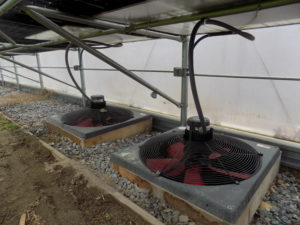
From each intake manifold, seven corrugated-plastic tubes were laid horizontally, extending across to one of the output manifolds. Tubes from two intake fans lead to each output manifold. Only one of the seven tubes goes directly to the output manifold; the others are in pairs that bulge outward at increasing distances before coming back together at the output manifold, like the lines in an onion.
The tunnel footprint was then filled in with 2 feet of soil. Another set of horizontal hoses was placed at 6-foot depth. The process was repeated depths of 4 and 2 feet as well. Each output manifold thus has 56 tubes, 28 from each of two intake manifolds. The tubes are porous but covered with a “sock” so that air diffuses but soil cannot block the pores.
Once the floor of the tunnel was filled with soil to surface level, the high tunnel was constructed. The underground tubes now spread warm daytime air throughout the soil under the entire high tunnel to a depth of 8 feet. The air warms the soil. At night, the fans push air out of the warmed soil.
With this system, using much less energy than burning propane, Epstein has kept the tunnel at 40° F or higher, even when the outside temperature plummeted to 10° F on Christmas Eve.
Electronic sensors and controls enable Epstein to use a smartphone app to set the temperatures at which the fans turn on and off and to monitor the temperature at several sites in the tunnel.
At one point, the temperature dipped below the set point of 400 F, so he checked and found some 1-inch gaps in the wall of the intake side of the tunnel. Once the gaps were fixed, the temperature was under control again.
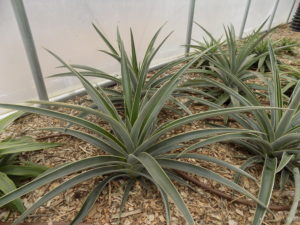
In addition to keeping the tunnel above 400 F in winter, the climate battery, with some misting, keeps the tunnel below 900 F in summer. Within this temperature range, Epstein can grow tropical and subtropical plants such as citrus and avocado trees and pineapples along the left side of the high tunnel.
In the center, he has grown three rounds of cover crops since the tunnel was built last spring, but soon he will keep the central area planted in annual vegetable crops such as tomatoes and cucumbers.
The right side is lined with work benches for starting seeds. Heat mats help keep the seedlings warm.
The large upfront investment in building the climate battery high tunnel is now providing a perfect environment for growing a variety of organic crops, with only low energy requirements for running the fans, heat mats and water pump.









